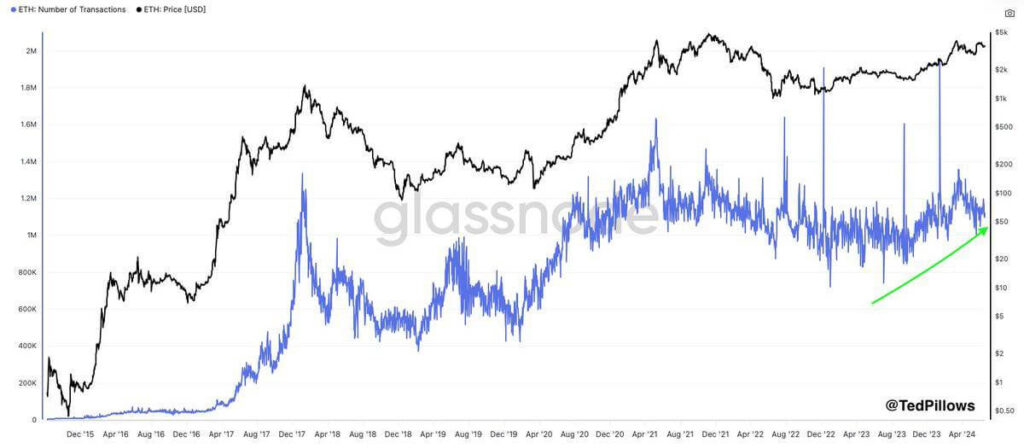Ethereum transactions are trending higher, showing sustained on-chain usage even as futures open interest fell from late-August peaks. Daily transaction counts remain in an uptrend, while ETH price consolidates near $4,300–$4,450 as leveraged positioning eases and market participants reassess risk.
-
Ethereum daily transactions uptrending despite price volatility
-
Open interest spiked above $70B in late August, then cooled to $58–$60B with the price correction
-
ETH trades in the $4,300–$4,450 band with futures activity stabilizing after recent liquidations
Ethereum transactions show resilience as futures open interest cools; read the update and trading implications. Full on-chain analysis and actionable takeaways — read now.
What are current Ethereum transactions trends?
Ethereum transactions are trending higher, with daily counts showing a steady uptrend that has persisted through volatile price moves. On-chain metrics indicate growing activity driven by stablecoin flows, Layer 2 adoption, and sustained dApp usage.
How did network activity evolve historically and since 2023?
Between 2016 and early 2018, ETH saw price peaks near $1,400 with volumes above 1.2 million daily, supported by ICOs and early dApps. After the 2018 decline, volumes fell to 400,000–600,000 daily but remained indicative of base utility.
During 2020–2021, DeFi and NFT growth pushed daily transactions back above 1 million as ETH surpassed $4,000. The 2022 drawdown reduced price below $1,000 but transaction bands held between 700,000 and 1.2 million per day, reflecting persistent usage.
From 2023 onward, transactions gradually rose again, aided by Layer 2 solutions and broader dApp participation, supporting a durable increase in on-chain throughput.

How has futures open interest and price behaved recently?
Open interest in Ethereum futures spiked above $70 billion between August 22–24, coinciding with spot tests of the $4,800–$4,900 range. This reflected aggressive leveraged positioning by traders.
By August 25, open interest declined, settling near $58–$60 billion by early September as profit taking and liquidations reduced leverage exposure. ETH price corrected from highs near $4,800 to consolidate around $4,300–$4,450.

When did open interest peak and what followed?
Open interest peaked above $70B in late August as leveraged traders increased exposure while ETH neared $4,900. Following profit taking and partial liquidations, open interest fell to $58–$60B by early September, coinciding with a price consolidation between $4,300 and $4,450.
Summary comparison of late-August vs early-September metrics
| Metric | Late August (peak) | Early September (current) |
|---|---|---|
| ETH price range | $4,800–$4,900 | $4,300–$4,450 |
| Futures open interest | > $70B | $58–$60B |
| Daily transactions | Uptrend above baseline | Consistent uptrend |
Frequently Asked Questions
Are Ethereum transactions increasing despite price volatility?
Yes. Ethereum daily transactions are on a steady uptrend, reflecting persistent network utility driven by stablecoins, Layer 2 adoption, and dApp activity even while prices fluctuate.
How does falling open interest affect ETH price risk?
Lower open interest typically reduces system-wide leverage and limits cascading liquidations, which can lower near-term volatility risk and create a more stable consolidation phase for ETH price.
Key Takeaways
- Network resilience: Daily Ethereum transactions remain in an uptrend, signaling ongoing utility.
- Futures cooling: Open interest dropped from >$70B to ~$58–$60B after late-August peaks, indicating reduced leverage.
- Trading implication: Consolidation near $4,300–$4,450 suggests cautious re-entry for leveraged traders; monitor on-chain and open interest for confirmation.
Conclusion
Ethereum transactions show sustained growth even as futures activity cools, demonstrating underlying network demand. Traders should watch open interest and transaction trends as leading indicators of risk appetite. For readers, continued on-chain monitoring will clarify whether the uptrend in transactions feeds future price strength.




